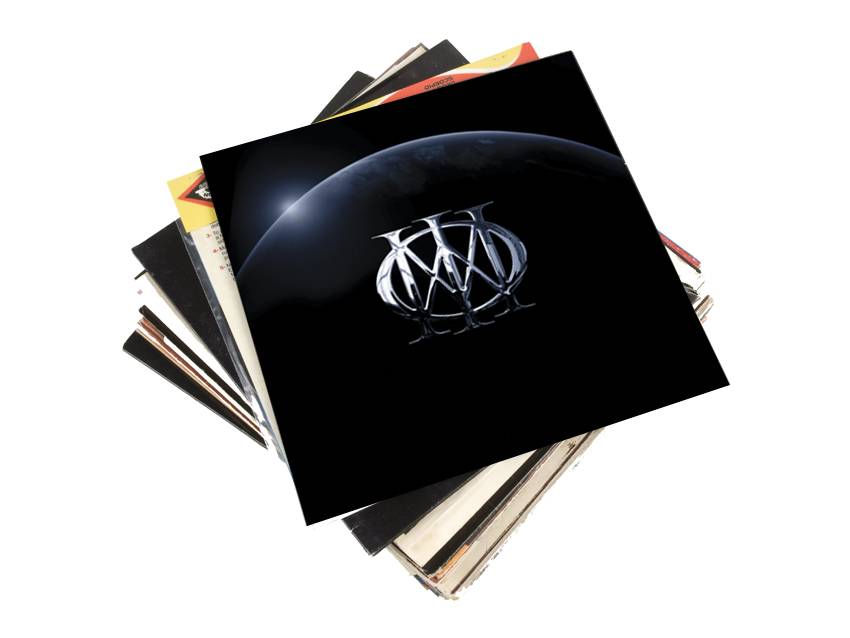
Jordan Rudess talks Dream Theater's self-titled new album track-by-track
“Every time I walk into a studio, I have the same thought in my head," says Dream Theater keyboard ace Jordan Rudess. "‘Can you do it? Can you really write something that good again?’ It’s almost like I can’t remember how I did things before, as if it were somebody else. A little bit of self-doubt creeps in – it’s normal. So it’s always a good feeling when, somewhere in the middle of recording, I go, ‘Oh, my God! Look at all this crazy stuff I wrote. How did that happen?’ The creative process is so mysterious and magical."
For Rudess and the other members of Dream Theater – guitarist and producer John Petrucci, vocalist James LaBrie, bassist John Myung and drummer Mike Mangini – the magic that would attend the recording of their masterful self-titled new album came first not from jamming or listening to demos but by thoughtful discussions about what kind of record they planned to make as a follow up to 2011's A Dramatic Turn Of Events.
“A lot of things build up to us making a Dream Theater record," Rudess says, "but the act of simply sitting down and talking things through is so important. Some records evolve in a sort of open-ended process in the studio, but we like to have an idea and a plan. We kind of like to see it before we start."
Mike Mangini had just joined the band before the recording of A Dramatic Turn Of Events, and the music had already been written, but for the new set he was an integral part of the song structuring process from the outset. “There was no question that we were a real unit now," says Rudess. "With Mike really locked in, the pieces fit together so well. We’d spent a whole year out there with people telling us with their applause and their emotions that this was good, that this was working. The affirmation from our fans that the new Dream Theater was something that could move into the future really energized us as we went into the studio again."
For Rudess, whose company Wizdom Music has introduced a whole host of groundbreaking music-making apps, the recording of the new album gave him a chance to explore a broad range of sonic tools. "I really get to go crazy with sounds in the studio," he says. "The software that I used the most is Omnisphere by Spectrasonics. It has a well of beautiful, amazing sounds – you can never get bored with it. The other piece of software that I used a lot was Camel Audio’s Alchemy, which is probably the most amazing software synthesizer I’ve ever heard. It has such a great library of sounds. For piano sounds, I used Ivory Synthogy. That’s my go-to software – the Omnisphere, the Alchemy and Ivory.
“For some strings parts, I’ll use Vienna Strings. I also use Kontakt by Native Instruments for certain sounds. Basically, I have a big party in the studio with my toys. It’s very different from when I’m on the road and I have to consolidate everything."
As for the decision to apply a self-title to the album, Rudess says that it's a reflection of the unity the band is feeling. “It’s kind of a big deal, really," he asserts. "The band has been together for so long and has done so many records, but it makes sense to go with the self-title now because we’re in such a good place. The energy is evenly distributed and is coming at you from all sides, so it’s a wonderful time to do this and to call it Dream Theater. It's a simple title, but it's big – it says a lot."
Dream Theater will be released on September 24th. You can order a Limited Edition Collector's Box Set at this link. On the following pages, Jordan Rudess walks us through the writing and recording of the album track-by-track.
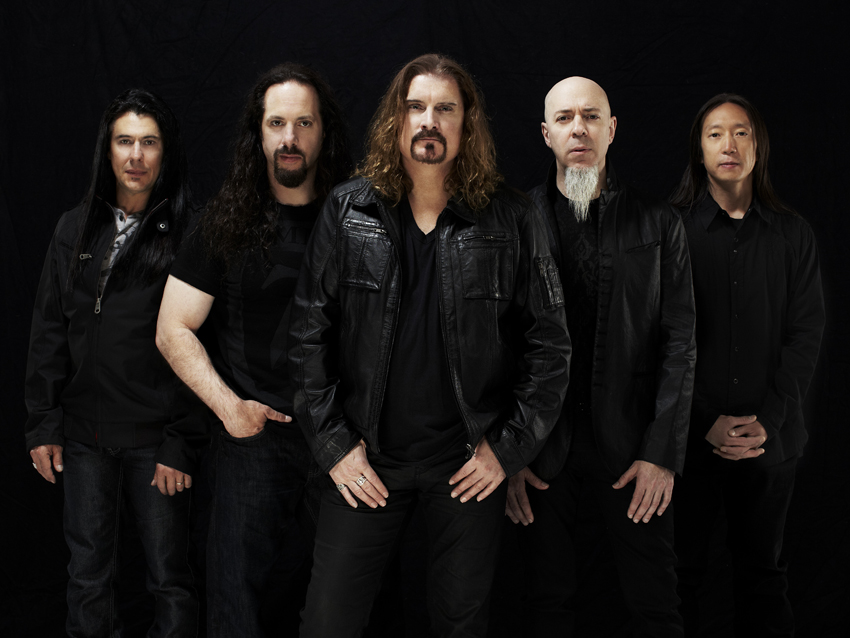
False Awakening Suite
“John Petrucci and I sat in a room and put this together. John had an idea of where he wanted it to go. The concept was basically that, instead of using somebody else’s big movie score to open our show, we would write our own piece of music to bring us out onstage. The plan sounded good to me, so I said, ‘Let’s do it.’
“John explained that he wanted something very big and cinematic, like the kinds of things we would use in the past, and I was like, ‘I got this.’ [Laughs] I called up the biggest patch I could on my Kronos. Brass, timpani, strings, voices – you hit the keys and it’s like, ‘Wow!’ Just two hands on the keyboard gives you all that sound. So that was very inspiring to write with that kind of tool.
“It was me at the keyboard the whole time; John was going back and forth with ideas: ‘Yes, no, maybe. Try this, try that’ – he was very much producing it and shaping it while I was composing. It was a lot of fun. After two or three hours, we emerged with a base.
“Then demo was on my Kronos, but then when we fleshed it out, with Mike adding drums and the two Johns adding guitars and bass. That’s when I pulled out my software, like the Vienna Symphonic String Library and CineSamples CineBrass. Oh, and I used a library from Heavyocity called Damage – that sounded pretty cool. All the big guys in Hollywood use Damage for crashes and explosions. We had such a blast with that.
“Of course, the other big development was when a young protégé of mine, Eren Basbug, took what I played and fleshed it out for a string ensemble. We arranged it all, and then he came in and conducted the strings. The whole thing really sounds incredible.”
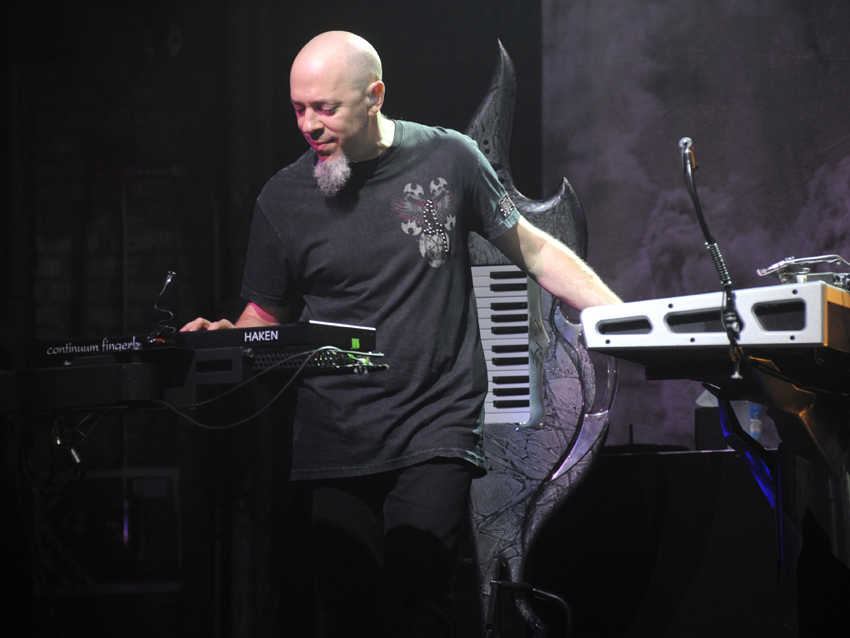
The Enemy Inside
“One of the things that John gets into on the guitar is the grungy kind of fast, low notes. I always leave him alone in that regard because sometimes I can’t relate at first, but I always know that he’s up to something. It’s like an eternal night vibe – the guitar is basically growing. I’m like, ‘OK, go with it.’ That’s how the piece started out.
“We started to think of having these big choruses, ones that almost hug you. I was talking to John Myung about it, how some of the music we like has these huge openings where you’re like, ‘Wow, thank you!’ Before we went in to record, I was analyzing what it was about those parts that makes you feel like that, and it gave me some ideas for the chordings and harmonies that we chose.
“I think of The Enemy Inside as a really good Dream Theater song that has all of the elements in a really concise way: It’s got the hooky chorus; the grungy, metal-y guitar; and it also has the wacky keyboard stuff that I love to do. I like to offer some humor in the music. Sometimes there needs to be a bit of a smile in the middle of such drama.
“I know that I want to use a motif, a theme, a harmony, and I’m going to turn it around – it’s almost like variations. Years ago, in The Dance Of Eternity, I did a little honky-tonk bit. Everybody laughed and said, ‘Yeah, do it!’ So, not to repeat ourselves, but it’s nice to add a light, fun, happy touch when you can. The part that’s in Enemy isn’t ‘funny’ per se, but it takes you on a little journey for a while.”
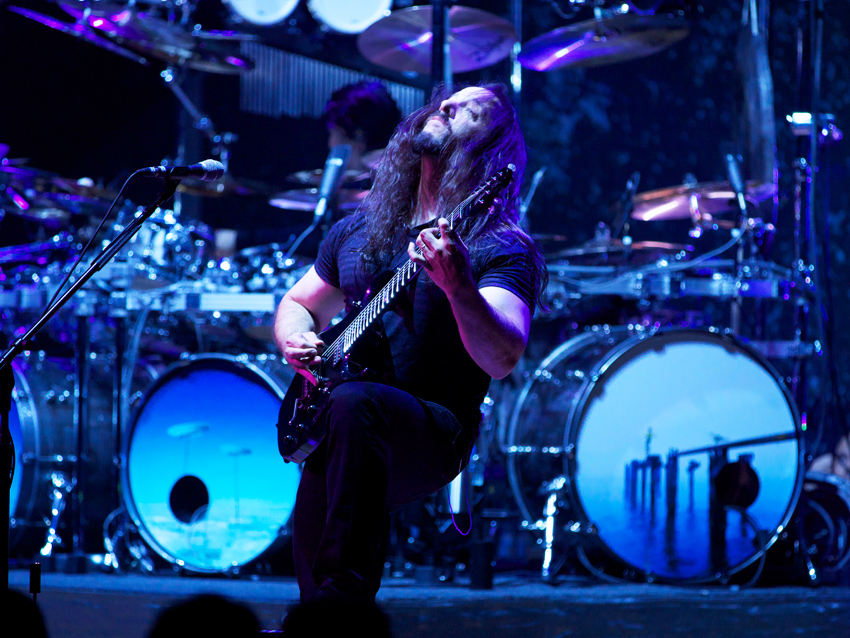
The Looking Glass
“As a keyboardist, there’s so many ways I can do things, as was the case in this song. I’d written something that was very progressive, kind of contrapuntal against the guitar towards the beginning. I thought it was pretty cool – and it was cool – but when we listened to it, I realized, and we all realized, that it had to be more inside the whole thing.
“The song is kind of Rush-like, so if what I’m doing takes it out of the core too much, then I have to rethink what my approach is going to be. And that’s OK – I love being inside the music because we’re all working together to create a sound and a mood. My ego is in a very good place. When you hear me, you hear me, and when you don’t, well, I’m still in there somewhere. That whole approach is prevalent in the song.”
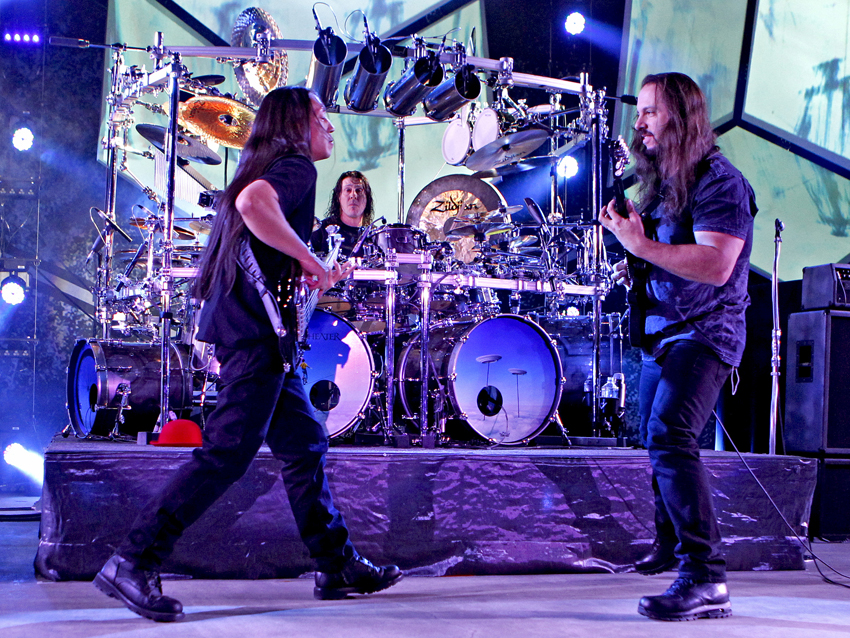
Enigma Machine
“We really wanted to create an instrumental. It’s something that we love to do, and we haven’t done one in a long time. So we basically said, ‘You know, guys, let’s do an instrumental for this album. It’s time!’ And James is cool with it. He appreciates that we have some long pieces to play so he can go into his tent and do whatever he does in there. [Laughs]
“It was a lot of fun. We wanted to come up with a riff that was really hooky and cool. I don’t know if we were thinking Pink Panther-ish or a television-worthy kind of theme, but we were playing around with those concepts. I felt as though I had my homework cut out for me because I was determined to come up with exactly what was needed.
“Funnily enough, the main riff came to me in my sleep the night before we wrote it. I was running everything in my mind – it’s gotta be catchy, it’s gotta be progressive, there should be a theme, all of that – and there it was! It reminded me of the riff to a TV show, but it was also Dream Theater-like. I went to the studio and said to John Petrucci, ‘I got something, but I don’t know it you’re going to like it.' I was having a moment of self-doubt. But he really liked it. He added to it, and we went back and forth, and it was extended, and that was that.
“There’s a bunch of cool parts – we’re trading leads, we’re trading harmonies. I even did an iPad solo, too, which I have to thank [engineer] Rich [Chycki] for – one day, he went, ‘Hey, Jordan, bust your iPad out!’ It’s fun to do something quirky and crazy like that. I sat down right in front of the mixing board and went to it. My company Wizdom Music makes an app called Geo Synthesizer, and that’s the one I used with the iPad. I fed the sound to Rich, and he dialed in a couple of effects for it – he gave it a bit more grunge – and next thing you knew, it was absolutely killer.”

The Bigger Picture
“This started out as a part from The Enemy Inside. That was a good move, I have to say. Dream Theater have no shortage of ideas – we just throw so many things out there. It’s always like picking up a handful of colors and throwing them at the wall. You can’t stop the inspirations when they come, but that doesn’t mean everything is always appropriate for that place and time.
“In looking at the ideas, we had to say, ‘OK, this part is great, but maybe it’s another kind of thing.’ First of all, we didn’t want to make our songs too long – well, we do have the 22-minute one in there [laughs]. But we did want to be to the point. So, finally, we took part of The Enemy Inside and it started to become The Bigger Picture.
“This is one of my favorites. I really like how broad and cinematic it is. It moves so beautifully harmonically and just feels so huge.”

Behind The Veil
“The intro was a lot of fun because I got to do my thing. It started out kind of orchestral, but then we thought that maybe we should go in another direction. People left it up to me somewhat – everybody was pretty busy with some other things – so I started working on a cinematic idea but one that wasn’t orchestral; it would be more otherworldly.
“It wasn’t going to use violins or trumpets or French horns, but it was going to use these other beautiful sounds. I called upon the Alchemy program because it has this Dream Voices collection of sounds. I had such a good time in the studio with Rich, just finding all of these sounds and saying, ‘Oh, that’s a great one. Let’s record that.’ And each sound would start to change the music and dictate where things were going. This song allowed me to use the Roli Seaboard, too, so I was able to call up some otherworldly sounds and instruments, as well.
“This song is another good example of what happens very naturally with us. Dream Theater is something of a musical melting pot, so it makes sense and feels right for us to have a lot of different styles happening on top of each other. That feels more right than having something that is just one thing, one approach, throughout."
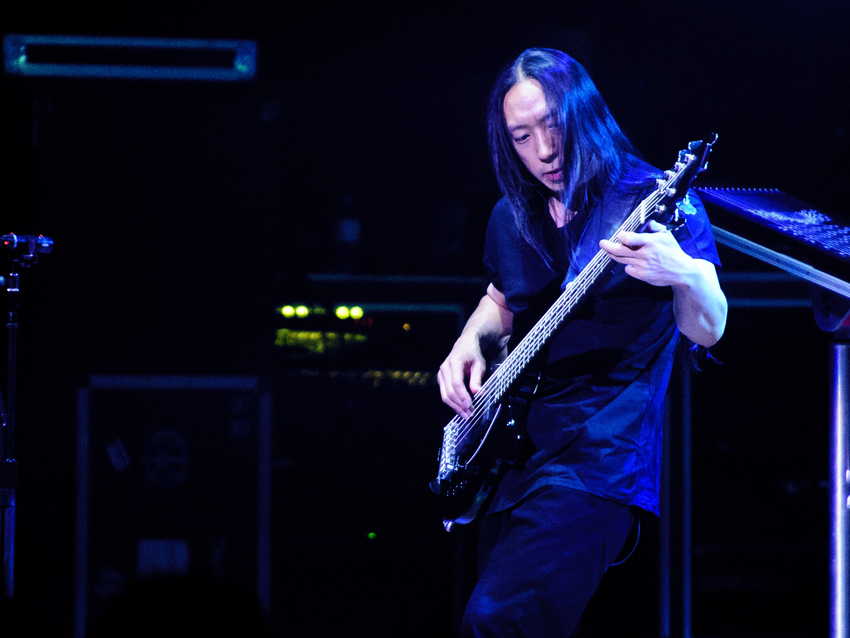
Surrender To Reason
“This was the first song we worked on. It’s funny: It’s always a little hard to get started – a little scary, too, I guess – but once we get a few things under our belts, or even a song, then we’re going for it. We had a lot of discussions about things, and then we went in and just did this – it happened very quickly and naturally.
“What’s so cool about this track – what’s cool about the whole record, really – is the way John Myung really dialed in his bass tone. He makes more of an impact on this record than probably any other record we’ve done. Rich was very helpful in this regard, maybe because of his history working with Geddy Lee. John and Rich got such a happening bass tone. It makes such a difference – it’s very biting and present.
“John has a nice bass moment in the song. It goes by quickly, but he’s doing some cool stuff. We always encourage him to do things like that – ‘John Myung, you do some great stuff, man! Let’s see what you got!’ He always gets excited where he has those spots to step out.”
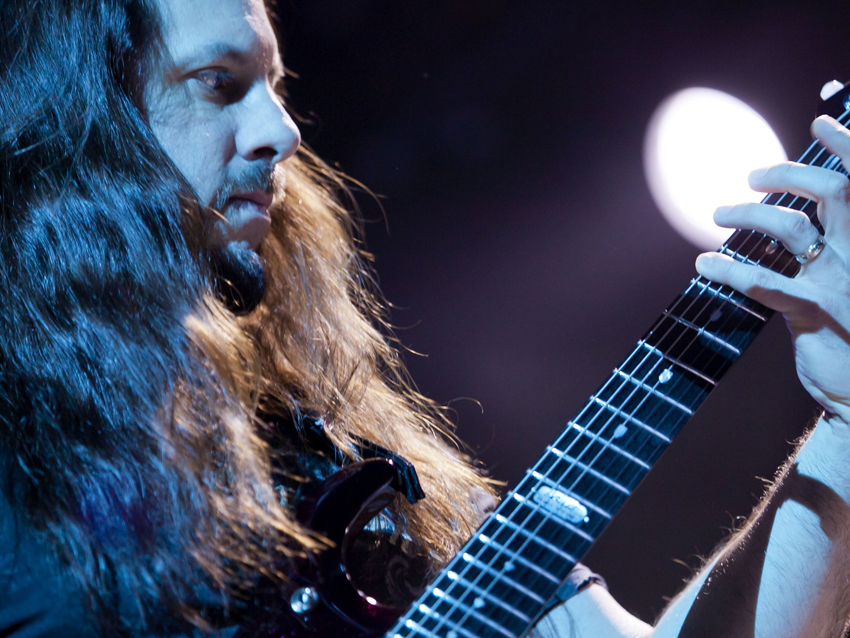
Along For The Ride
“The solo is very much of a Keith Emerson Lucky Man-ish type of sound. We were working on the song – John Petrucci was doing some chords and some other nice things – and I poked my head in and said, ‘Hey, how about a cool keyboard lead?’ Because it was going the other way for a bit, a little more acoustic, so I thought that maybe we should make a more Dream Theater-like.
“At first, I don’t know if he was that into it [laughs], but he thought about it and finally said, ‘OK, let’s give it a try.’ What was funny about that lead is, I didn’t really have anything planned. I just said, ‘Let me wail away on something here,’ and that’s the solo that’s on the album! I just winged it, looking at the chords, working through the changes but thinking that it was just a rough. Every time we played it back, though, the guys all thought it was the keeper.
“As a synthesist in a rock band, there’s a few sound choices I could pick from. There’s a ‘Jordan’-type lead, that burning wild thing that I do, or I could pick up my Geo Synthesizer. But I decided to go for a classic lead sound, a very open Square Wave with a bunch of echo – totally Lucky Man. For me to do a little tip of the hat to my hero, Mr. Keith Emerson, feels very cool.”
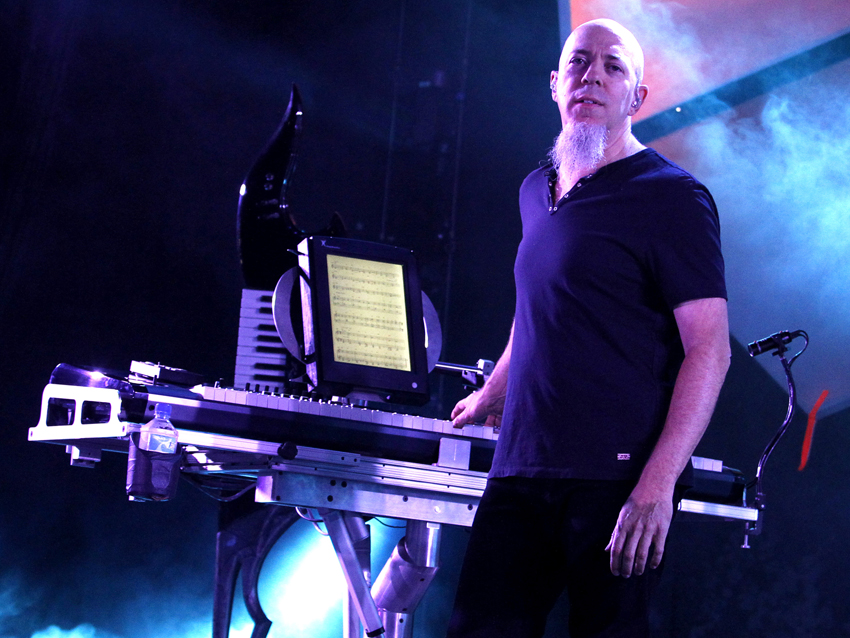
Illumination Theory
“We were all feeling like we needed the chance to stretch out. Everything we were doing was kind of concise, and every so often one of us would say, ‘We really need to go crazy.’ So we decided to get wild and wacky and do a real epic.
“John Petrucci had been playing with a beautiful theme, which was originally slated for another song, but again we took it and moved it to its own special place. We worked on it together and refined it, and it started to feel really majestic. The whole thing started to grow.
“This is a great example of what Mike Mangini brings to us, which is this extreme rhythmic brain that can conceptualize very interesting ideas for rhythms that can go together. Like, ‘If you play 10 bars of seven and you play four bars of five, it’s going to sound really cool.’ We would make notes and put these things together. That gave me a nice chance to pull out some music paper and write counterpoint stuff. I have these almost Bach/Gentle Giant things in there, and that was a lot of fun to work on.
“There a whole middle section that features a lot of ambient electronic sounds. It’s spread out and very relaxed, and it slides into a string ensemble part – just strings, like they’re out of a little movie. The soundscape is something that John Petrucci and I organized. We were together in front of my computer, but I would be playing and finding sounds, vibing out. I was running my own sequencer. It was great, the two of us feeling it out and creating this experience.
“The string part was one of those funny times in Dream Theater where John will say to me, ‘Jordan, play the saddest, most beautiful melody you can.’ [Laughs] And I’ll go, ‘All right, I’ll try.’ I’ll called up a sound and improvised, and he said, ‘That’s it! That’s perfect.’ I modified it a little bit, and then we sent it to Eren, who fleshed it out for real strings. They came in and recorded it, and it turned out great. It’s so beautiful.
“And there’s the last little bit, this nice vibey thing I did at home. I was playing it, these three chords, and I loved it. I didn’t know what the guys would think, but I played it for them, and John Petrucci was like, ‘That’s really cool.’ So we decided that it would be a neat surprise at the end. It’s piano, guitar and Seaboard. It relaxes things after this enormous trip you’ve been on. So if you’re still listening, if you hang in there, that’s how we tag it out.
“As you might expect, the piece was composed in pieces, so we didn’t play it live from beginning to end, even as a scratch track. But we’ll play it in its entirety live – we definitely have some woodshedding ahead of us. It’ll come together methodically. I’ll have my notations, I’ll get my sounds together for each part, but once I work out what I need to do, I’ll be able to play it. It’s a big tune, so there might be some challenges. That’s OK.”

Joe is a freelance journalist who has, over the past few decades, interviewed hundreds of guitarists for Guitar World, Guitar Player, MusicRadar and Classic Rock. He is also a former editor of Guitar World, contributing writer for Guitar Aficionado and VP of A&R for Island Records. He’s an enthusiastic guitarist, but he’s nowhere near the likes of the people he interviews. Surprisingly, his skills are more suited to the drums. If you need a drummer for your Beatles tribute band, look him up.
"At first the tension was unbelievable. Johnny was really cold, Dee Dee was OK but Joey was a sweetheart": The story of the Ramones' recording of Baby I Love You
"Reggae is more freeform than the blues. But more important, reggae is for everyone": Bob Marley and the Wailers' Catch a Fire, track-by-track
"At first the tension was unbelievable. Johnny was really cold, Dee Dee was OK but Joey was a sweetheart": The story of the Ramones' recording of Baby I Love You
"Reggae is more freeform than the blues. But more important, reggae is for everyone": Bob Marley and the Wailers' Catch a Fire, track-by-track









